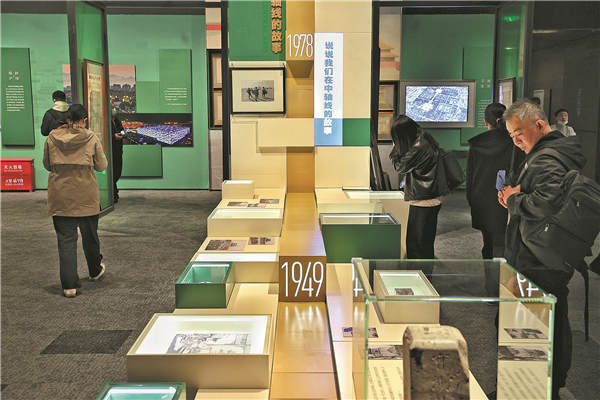

The Beijing municipal government has also released a number of policies and regulations to preserve the heritage sites, and has been working with institutions and organizations to increase public awareness and involve citizens in using and protecting these sites.
"When designing the exhibition, the team held a lot of discussions and explorations. We feel that for visitors, seeing the cultural artifacts alone doesn't offer a clear understanding of the cultural significance of the Central Axis," Zhong says.
"So, we provided a lot of explanations and interactive devices for the visitors to explore and experience, which helps them better understand the meaning and theme of our exhibition."
These interactive installations include a hanging scroll of a map. By spinning the wheel device beside it, the visitors can scroll up or down, select a specific site they would like to learn about, and read about its history on the screen placed on top of the scroll.
After viewing the exhibition, the visitors will arrive at a digital photo booth. On the floor, an outline of the Central Axis is drawn. By standing on different spots along the line, the visitors get to choose a representative landmark to their liking, which will appear on the screen as the photo background.
They can then strike a pose, get their photos taken after the countdown, and download the photos by scanning the QR code outside the booth.
Before the opening of the exhibition, the museum also gathered from the public old photos and everyday items that are associated with the Central Axis.
These old objects include an enamel mug with a picture of the Temple of Heaven, a notebook with printed image of Tian'anmen Square, and a ticket to the Spring Festival gala in the 1980s.
"Seeing these old objects will remind the visitors that the Central Axis is truly closely connected with their everyday lives. It's a way of deepening people's experience and emotional connection with the Central Axis and Beijing," says Tan Xiaoling, deputy director of Capital Museum.
"Perhaps ancient capitals are often considered remote and solemn, but from this exhibition, we'd like to present the vibrant cultural phenomena and activities that have taken place on the Central Axis of Beijing, and the effort our country and people have made to inject new energy into their heritage."